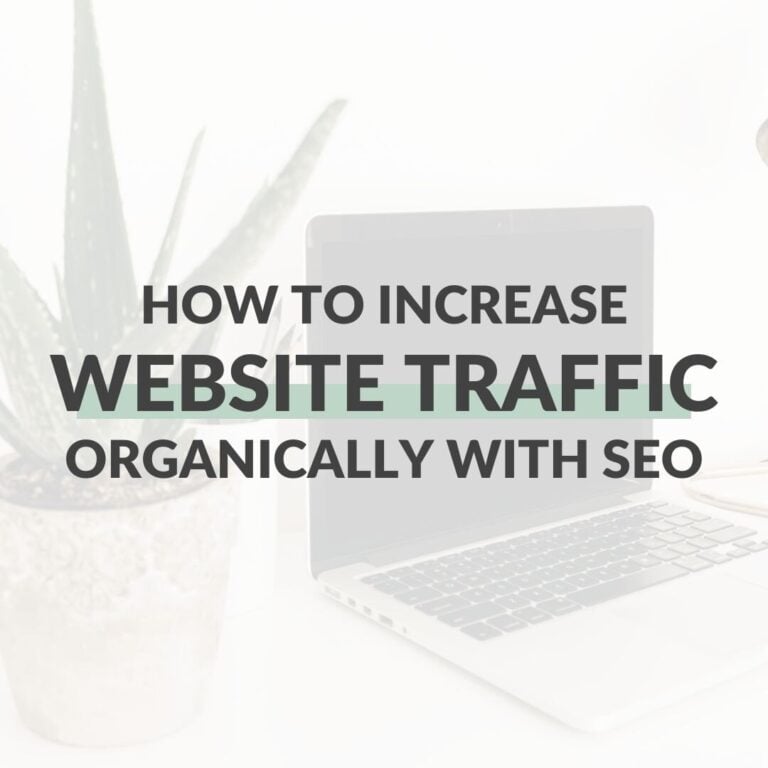What Is SEO? Best Practices for Search Engine Optimization
What is SEO? Let’s go over the types of SEO, and best practices for implementing these strategies on your blog!
SEO, or Search Engine Optimization, increases your website’s organic visibility on Google and other search engines. In the last year or so, I’ve learned search engine optimization techniques and how they help me appear in search results.

So, I’ve personally discovered the power of SEO, and I want you to do the same. SEO matters, and it can transform your online business too.
What is SEO?
SEO stands for Search Engine Optimization. It is a process of optimizing a website or a web page to increase its visibility and ranking in search engine results pages (SERPs).
The main goal of SEO is to drive organic traffic to a website by improving its relevance and authority in the eyes of search engines like Google, Bing, and Yahoo.
SEO involves keyword research, on-page optimization, link building, and content creation to make a website more user-friendly and a search engine.
By implementing effective SEO strategies, businesses can improve their online visibility, generate more leads, and increase revenue.
As mentioned above, Search Engine Optimization is a process that allows your website to gain visibility on search engines such as Google.
One of the first steps in working you way toward SEO is performing keyword research. Think about the last time you search for an answer on Google. You didn’t just type in “Pinterest” when you wanted to learn how to create better pin images. You probably searched for “best-performing pins on Pinterest,” or “how to create a pin graphic that goes viral” or something more extensive.
Why? Because you want to learn how to do something specific and you expect Google to show you the best resources first. How often do you scroll past the first 2 or 3 results? My guess is, never, unless you’re writing an academic paper.
Why is SEO important?
SEO is important because it helps businesses improve online visibility and attract organic traffic. Here are some reasons why SEO is important:
Increased visibility
SEO helps businesses to rank higher in search engine results pages (SERPs), which increases their visibility and exposure to potential customers.
Improved user experience
SEO involves optimizing a website’s structure, content, and navigation to make it more user-friendly and easy to use, improving the user experience and encouraging visitors to stay longer.
Higher credibility and authority
By ranking higher in search results, businesses can establish themselves as credible and authoritative sources in their industry, which can help build customer trust and loyalty.
Increased traffic and leads
With more visibility and higher rankings, businesses can attract organic traffic to their website, leading to more leads, conversions, and sales.
Cost-effective marketing
SEO is a cost-effective marketing strategy compared to other forms of digital marketing, such as paid advertising, and can deliver long-term results if done correctly.
Overall, SEO is important for businesses that want to improve their online presence, attract traffic, and generate more leads and revenue.
What Are 4 Types of SEO?
There are several types of SEO, but here are four of the most common types:
On-page SEO
This type of SEO focuses on optimizing individual web pages to improve their relevance and authority for specific keywords. On-page SEO techniques include optimizing the title tags, meta descriptions, header tags, internal linking, and web page content.
Related: How to Create Google Web Stories
Off-page SEO
This type of SEO focuses on building external links to a website to improve its authority and credibility in the eyes of search engines. Off-page SEO techniques include link building, social media marketing, and guest blogging.
Technical SEO
This type of SEO focuses on improving the technical aspects of a website to make it more search engine friendly. Technical SEO techniques include optimizing the website’s structure, improving page speed, and implementing structured data markup.
Local SEO
This type of SEO focuses on optimizing a website for local search queries. Local SEO techniques include optimizing the website’s Google My Business profile, building local citations, and getting customer reviews.
By implementing these SEO techniques, businesses can improve their online visibility, attract more traffic, and generate more leads and revenue.
How to Save Time on SEO
You’re a small business owner trying to run an online business. Whatever your business is, you’re focused on spending your time working with your own clients and being a solution to their problems.
SEO Marketing is initially confusing, so I want to create this resource for you. Knowing what Google wants will help you improve your content creation, so I was hoping you could keep this information in mind as you write content for your website.
Related: Proven Ways to Increase Website Traffic
What is Google Looking For?
Google wants to remain the best search engine out there. They do that by providing the best user experience, meaning they need to stay relevant with the internet’s most up-to-date and quality content.
Long Tail Keywords
As I mentioned already, if you’re searching for something on Google, you’re not typically searching for “Pinterest.” Instead, you’re searching for “how to create viral content on Pinterest” which is considered a long-tail keyword. These keyword phrases are longer and more specific on a particular topic.
Evergreen Content
Keyword research should be the first thing you do. What questions are your customers asking? What do they need help with? What are they searching for on Google?
I used a Google Chrome extension called Keywords Everywhere that helps me create extensive lists of keyword phrases to pull from. Once you have a list of keyword phrases that’ll help you connect with your audience, you can start plugging them into your website content.
If you’re unfamiliar with evergreen content, here is a quick definition: this refers to the content on your site that remains relevant, regardless of the amount of time that passes. Articles like “Best Marketing Practices in 2019” are NOT evergreen content and must be updated yearly.
I’m NOT saying that you should never post content that is time-based. Sharing special offers or covering a trending topic can be a good thing. But as far as SEO is concerned, your content should stay relevant in the long-term. Google values content that will be valuable for years to come.
Titles and Meta Descriptions
Google loves catchy headlines. Also known as a title tag, this is the title of your blog post or web page. And the meta description is the text portion below the title tag on SERP results.
It’s typically 2 sentences or less and summarizes your blog post. Take a look at the screenshot below, and you’ll see how one of my blog posts appears on Google.
Headers
Have you worked on the backend of your blog yet? Chances are that you’ve noticed Header 1, Header 2, and Header 3 as some options. These options help make your content skimmable, and they’re a great way to plug in long-tail keywords into your content. However, please don’t overdo it. That’s called keyword stuffing, and Google’ll flag it.
Body Text
This copy refers to the content comprising the body paragraphs in your blog posts and web pages. You can also include keywords in your body text if you’re not overdoing it. Academic friends and passionate writers want to write long paragraphs with thorough sentences. However, the best SEO practices call for you to do the opposite.
Remember, skimmable content is a good thing. So, your body text should be short and simple. Side note: Google is prioritizing mobile-friendly sites. If the paragraphs are longer than 2-3 sentences each, your content isn’t easy to read on smartphones and tablets. Keep that in mind as you’re writing. The shorter, the better. Sorry to all the academic writers out there!
Benefits of SEO
Now that you know more about how to create SEO-friendly content, here is a summary on why SEO matters for your online business and blog.
Higher credibility and authority
By ranking higher in search results, businesses can establish themselves as credible and authoritative sources in their industry, which can help build customer trust and loyalty.
Better User Experience
Following SEO practices will help you create a better experience for your website visitors.
Who wants to visit a website where they can’t learn more about the business or how to contact? Or what they offer and what value they give? If people visiting your website can’t locate that information right away, they will click away.
SEO helps you organize your site and make it easier for visitors to contact you.
Long-Term Strategy that Converts
The sooner you focus on SEO, the better! Look, I knew nothing about SEO back in 2015 and 2016. I have old blog posts that I need to rework or delete (but I can’t completely delete old posts because that’s bad for SEO!) You can prevent that process from even happening if you get started today.
2/3s of search queries result in one or more clicks. What if one of those clicks leads to your website? The better your SEO is, the better results you’ll have!
Connect with Your Audience
Finally, SEO can help you connect with potential clients and customers. That’s the end goal for most business owners. SEO will help you grow traffic organically, meaning it’s FREE.
The truth is, posting on social media and investing in online advertisements has to happen frequently. That means that you have to be producing content to get results constantly. With SEO, your hard work will do the work for you long-term.
SEO Best Practices
Here are some SEO best practices that businesses should follow to improve their online visibility and rankings:
Conduct keyword research
Identify the keywords and phrases your target audience is searching for and optimize your website content accordingly.
Before you start, it’s important to understand search intent.
Search intent refers to the reason behind a user’s search query. It is a user’s underlying goal or objective when they enter a search query into a search engine. Understanding search intent is important for businesses because it helps them to create content that meets the needs and expectations of their target audience.
There are four main types of search intent:
- Informational intent: The user is looking for information on a specific topic, such as how to do something, the definition of a term, or the history of a particular event.
- Navigational intent: The user is looking for a specific website or webpage, such as a brand or company website, social media profile, or online directory.
- Commercial intent: The user is looking to make a purchase or engage in a transaction, such as buying a product, subscribing to a service, or booking an appointment.
- Transactional intent: The user is looking to complete a specific action, such as downloading a file, signing up for a newsletter, or filling out a form.
Use keyword research tools such as Google Keyword Planner, Ahrefs, SEMrush, Moz, or Ubersuggest to identify additional keywords and phrases related to your business.
Choose a primary keyword for each web page and identify secondary keywords related to the primary keyword.
Incorporate the primary and secondary keywords into your website content, including the title tag, meta description, header tags, and body content.
Optimize on-page elements
Optimize your web pages’ title tags, meta descriptions, header tags, and content to make them more relevant and engaging to users and search engines.
Use header tags (H1, H2, H3) to structure your content and make it easier for users and search engines to understand the information hierarchy on your web pages.
Improve website structure
Ensure your website has a clear and logical structure that is easy for users and search engines to navigate.
Build quality backlinks
Build high-quality backlinks from reputable websites to improve your website’s authority and credibility.
Create high-quality content
Create original, informative, and engaging content that provides value to your target audience.
Use social media
Use social media platforms to promote your content and engage with your audience.
Optimize for local search
Optimize your website for local search queries by creating a Google My Business profile, building local citations, and getting customer reviews.
Monitor performance
Use analytics tools to monitor your website’s performance and adjust as needed.
By following these SEO best practices, businesses can improve their online visibility, attract more traffic, and generate more leads and revenue.





